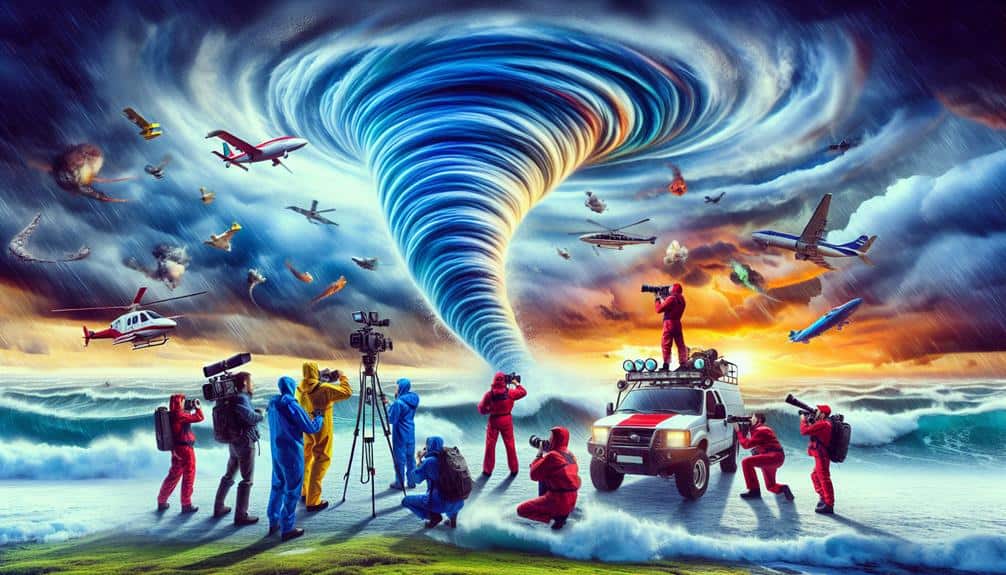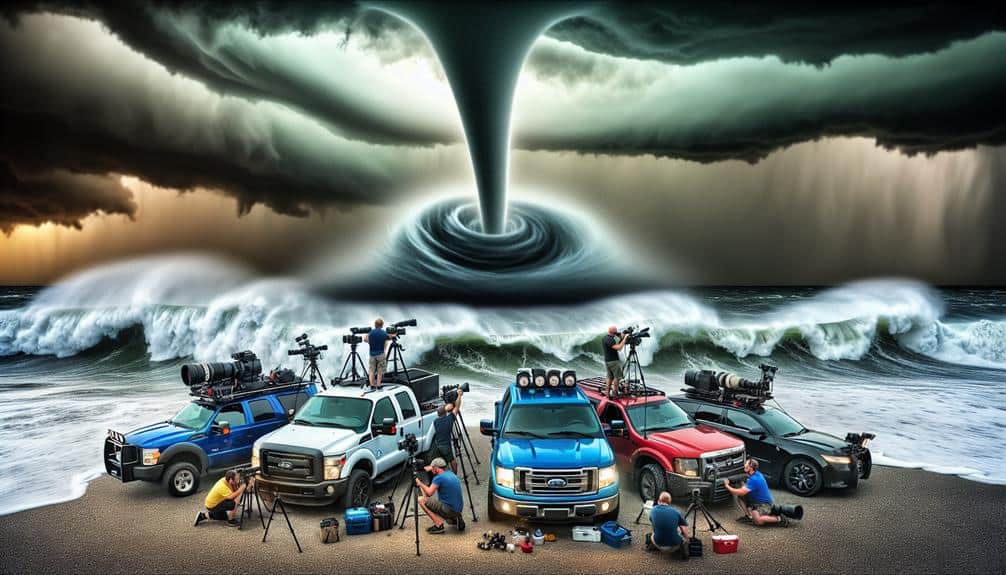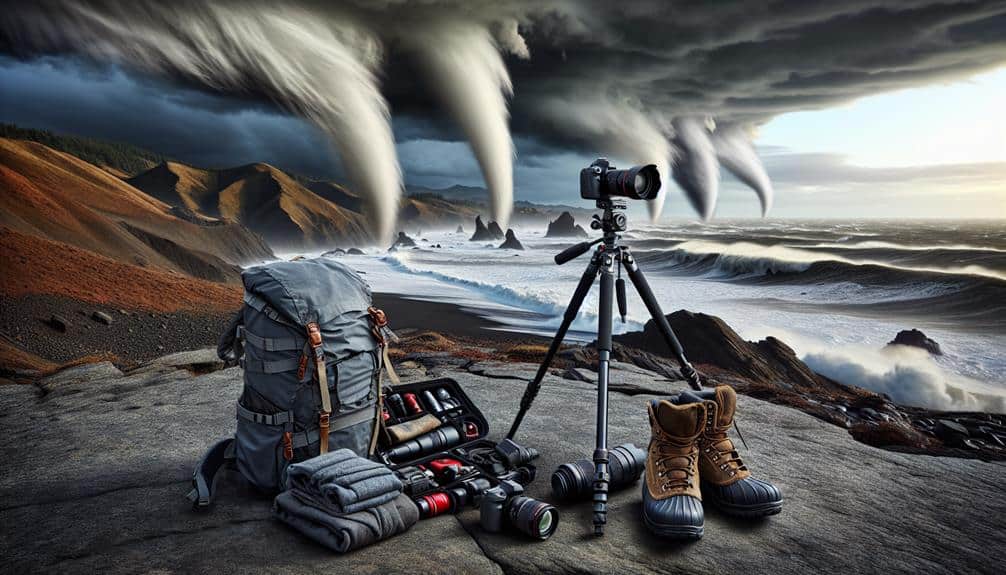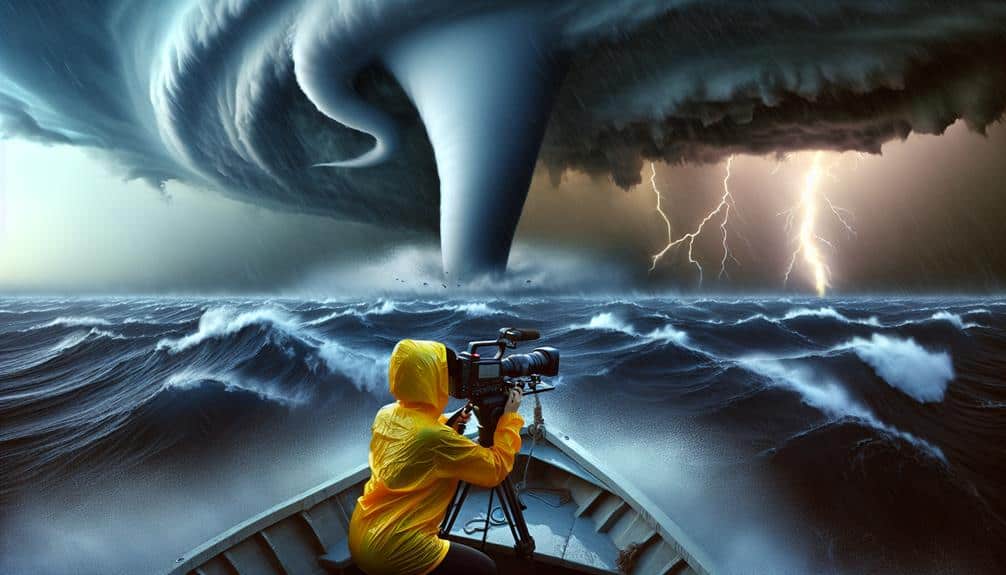As we chase waterspouts, we utilize high-resolution cameras and portable weather stations to capture precise data and imagery. These dynamic phenomena, forming over warm waters in tropical and subtropical regions, offer exciting insights into atmospheric dynamics. With sea surface temperatures, wind shear, and humidity levels as key factors, we analyze vertical wind shear and cloud formation intensively. By following safety protocols, such as maintaining a safe distance and staying alert to weather updates, our pursuit is both safe and thrilling. This journey deepens our understanding of atmospheric processes and reveals the fascinating science behind these mesmerizing events.
Key Points
- Waterspouts offer unique visual phenomena, providing an unparalleled thrill for weather enthusiasts.
- Capturing high-resolution images of waterspouts presents an exciting challenge for photographers.
- Real-time data from portable weather stations enhances the chasing experience.
- Monitoring live radar and satellite imagery adds to the adventure of predicting waterspout formation.
Understanding Waterspouts
Understanding waterspouts necessitates a detailed exploration of their formation, characteristics, and the atmospheric conditions that lead to their development. As a weather phenomenon, waterspouts captivate us not just because of their visual spectacle but also due to the intricate mechanisms propelling their existence.
To fully comprehend this phenomenon, we need to examine the specific meteorological conditions that support their formation.
Waterspouts generally form over warm bodies of water, where the temperature difference between the water surface and the overlying air can create a favorable environment for their development. These columns of rotating air and mist are often categorized into tornadic and fair-weather types, each with unique formation conditions. Tornadic waterspouts are essentially tornadoes that occur over water, while fair-weather waterspouts form in relatively calm, clear skies.
Data indicates that waterspouts are most prevalent in tropical and subtropical regions. The visual display they provide is both captivating and educational, offering us crucial insights into atmospheric dynamics. By researching these whirlwind phenomena, we gain a deeper admiration for nature's intricacy and a heightened comprehension of the atmospheric processes that govern our weather systems.
The Science Behind Waterspouts
Let's explore the mechanics of waterspouts by examining their formation and development, which hinges on specific atmospheric conditions and sea surface temperatures.
We'll classify the different types, from fair-weather to tornadic waterspouts, and analyze their unique characteristics.
Formation and Development
To grasp the formation and development of waterspouts, we must analyze the intricate interplay between atmospheric conditions, water temperature, and wind patterns. Waterspouts typically form over warm water bodies where specific conditions converge. The formation process begins with the development of a cumulus cloud, which often evolves from localized convective activity.
As this cloud matures, warm and moist air rises, creating a low-pressure area at the surface. During the development stages, the convergence of cool air aloft and warm air at the surface triggers a rotation. This rotation becomes more defined as the wind speed and direction shear vertically.
We rely heavily on observational data and tracking patterns to understand these phenomena better. High-resolution satellite images and Doppler radar data are indispensable tools in predicting and studying waterspout occurrences.
Key factors influencing waterspout formation include:
- Sea surface temperature: Warmer waters provide the energy needed for cloud growth and air uplift.
- Wind shear: Variations in wind speed and direction at different altitudes facilitate rotation.
- Atmospheric instability: Temperature gradients contribute to convective activity.
Types and Classifications
Diving into the classification of waterspouts, we identify two primary types: fair-weather waterspouts and tornadic waterspouts. Fair-weather waterspouts typically form in light wind conditions and aren't associated with thunderstorms. They arise from the surface upward, following specific weather patterns conducive to their formation.
On the other hand, tornadic waterspouts are spawned from severe thunderstorms and share characteristics with land-based tornadoes, forming from the cloud base downward.
Understanding the classification types helps us clear up common misconceptions. Many people mistakenly believe all waterspouts are dangerous, when in fact, fair-weather waterspouts are generally less hazardous. These formations are often weaker and shorter-lived compared to their tornadic counterparts.
Analyzing waterspout formations reveals that fair-weather waterspouts thrive in calm, humid conditions, whereas tornadic waterspouts demand intense atmospheric instability. Tornadic waterspouts can exhibit wind speeds exceeding 100 mph, posing significant risks if encountered.
Weather patterns play a pivotal role in differentiating these two types. Fair-weather waterspouts often appear in tropical and subtropical regions, while tornadic waterspouts are more common in temperate zones with frequent thunderstorms.
Safety and Precautions
Understanding the safety measures and precautions associated with waterspouts involves analyzing their formation dynamics, wind speeds, and potential impact zones. As thrill-seekers, we must approach these natural phenomena with a calculated risk assessment to guarantee our safety without compromising the exhilarating experience.
First, we need to comprehend the atmospheric conditions that foster waterspouts. These vortices typically form in areas with high humidity, warm water temperatures, and converging winds. By tracking these variables, we can predict the likelihood of waterspout formation.
Once we identify potential hotspots, the next step is to evaluate the wind speeds. Waterspouts can exhibit wind speeds ranging from 50 to 100 mph, posing significant risks to nearby vessels and structures.
Here are some essential safety measures:
- Stay informed: Regularly update ourselves with weather reports and warnings.
- Maintain distance: Keep a safe distance, typically a mile or more, from the waterspout to avoid debris and sudden shifts.
- Emergency plans: Have a clear evacuation plan and communicate it to all team members.
Essential Gear for Storm Chasers

For effective storm chasing, having the right equipment—such as high-resolution cameras, portable weather stations, and robust communication devices—is vital to both safety and data collection.
As storm chasers, we rely on high-resolution cameras to capture precise imagery and video of waterspouts. These visuals are pivotal for both analysis and sharing our findings with the broader meteorological community. Our cameras must perform well under low-light and high-motion conditions, ensuring we don't miss critical moments.
Portable weather stations serve as our mobile data hubs. Equipped with anemometers, barometers, and hygrometers, these devices allow us to measure wind speed, atmospheric pressure, and humidity levels in real-time. The data collected can be instantly analyzed to predict storm behavior and make timely decisions on our movements.
Robust communication devices, including satellite phones and two-way radios, are essential. They guarantee we stay connected with our team and emergency services, regardless of cell signal availability. Reliable communication is paramount for coordinating our efforts and ensuring our safety.
Lastly, let's not overlook essential safety gear. Quality helmets, weatherproof clothing, and sturdy boots are necessary to protect us from the elements and debris. Each piece of gear plays a vital role in our mission to chase and document these awe-inspiring natural phenomena.
Safety Precautions for Chasing
As storm chasers, we must monitor weather alerts rigorously to track waterspout activity in real-time.
Maintaining a safe distance, typically recommended to be at least 1 kilometer, minimizes risk exposure.
Additionally, an emergency preparedness plan guarantees quick, coordinated responses to any unforeseen incidents.
Monitor Weather Alerts
Relying on real-time weather alerts is crucial for us to anticipate and respond to the rapidly changing conditions associated with waterspouts. Accurate weather monitoring is our first line of defense, enabling us to make well-informed decisions and implement safety precautions. Integrating sophisticated alert systems can provide the critical seconds or minutes needed to adjust our course and execute emergency plans when necessary.
To effectively monitor weather alerts, we should focus on:
- Satellite Data: Utilizing high-definition satellite imagery to track cloud formations and atmospheric changes.
- Radar Systems: Employing Doppler radar to detect wind patterns and precipitation intensity, which are indicative of waterspout formation.
- Mobile Apps: Leveraging real-time weather monitoring applications that provide instant notifications and updates on severe weather conditions.
Maintain Safe Distance
Maintaining a safe distance from waterspouts is crucial; this requires us to consistently evaluate wind speeds and trajectory data to prevent hazardous close encounters. We need to employ real-time meteorological tools to monitor these variables closely. High-resolution radar and satellite imagery allow us to track the waterspout's development, guaranteeing our observations remain safe.
Data-driven decisions are key. By analyzing wind shear and sea surface temperatures, we can predict the potential paths waterspouts might take. This predictive modeling guides us in maintaining a buffer zone, typically recommended to be at least 1-2 nautical miles away from the phenomenon. Our commitment to hazards awareness ensures we avoid abrupt changes in the waterspout's intensity or direction.
We must also stay aware of secondary hazards like lightning, strong winds, and turbulent waters, which are often associated with these dynamic systems. Utilizing advanced GPS and communication devices keeps our locations precise and connected with broader meteorological networks. This gives us the freedom to chase waterspouts without compromising safety.
Prioritizing safe observation techniques and maintaining rigorous hazards awareness allows us to experience the thrill while respecting the power and unpredictability of nature.
Emergency Preparedness Plan
To guarantee our safety while chasing waterspouts, we must establish a detailed emergency preparedness plan that outlines specific safety precautions and protocols. This plan ensures we can react swiftly and efficiently in the event of an unexpected situation, allowing us to chase with confidence while minimizing risk.
Key components of our emergency preparedness plan include:
- Evacuation routes: We need pre-determined escape paths from any location, considering various possible weather developments.
- Emergency supplies: Our vehicles should be equipped with first-aid kits, non-perishable food, water, and essential tools to handle unforeseen circumstances.
- Family communication: Establish a robust communication plan with our families. Regular check-ins via satellite phones or radios can keep everyone informed of our whereabouts and safety.
Famous Waterspout Encounters

Throughout history, meteorologists and storm chasers have documented numerous famous waterspout encounters that provide invaluable data for understanding these fascinating phenomena. Among the most thrilling adventures was the 1997 Florida Keys outbreak, where 88 waterspouts were recorded in a single day. This event remains one of the most famous sightings, offering essential insights into atmospheric conditions conducive to waterspout formation.
Another notable encounter occurred on September 28, 2015, off the coast of Genoa, Italy. A waterspout, with wind speeds exceeding 100 mph, was meticulously documented, contributing to our understanding of the dynamics of intense waterspouts. The data collected from this event revealed significant temperature gradients and high humidity levels as vital factors.
In 2018, the Great Lakes region experienced an extraordinary sequence of waterspouts, with Lake Michigan being a hotspot. Researchers gathered extensive data on the lake's surface temperature, wind shear, and barometric pressure, enhancing predictive models. These famous sightings underscore the importance of real-time data collection.
Tips for Capturing Waterspouts
Building on the knowledge gained from famous waterspout encounters, capturing these phenomena requires understanding best equipment, ideal locations, and precise timing to maximize data quality. Our approach involves leveraging advanced photography techniques and storm chasing equipment. To begin, understanding weather forecasting is essential. We need to identify potential waterspout formations and position ourselves strategically.
Optimal gear includes high-resolution cameras with fast shutter speeds to freeze the dynamic motion of waterspouts. We also recommend using stabilizing tripods to counteract the instability caused by stormy conditions. Regarding filming strategies, capturing both wide-angle and zoomed-in shots provides a detailed view of the waterspout's structure and dynamics.
Here are some important tips:
- Weather forecasting tools: Utilize radar and satellite imagery to predict waterspout occurrences.
- Photography techniques: Master long exposure and HDR for capturing the full range of motion and lighting.
- Storm chasing equipment: Equip vehicles with GPS, anemometers, and communication devices for real-time data and safety.
The Community of Storm Chasers

The camaraderie and shared expertise within the community of storm chasers foster a collaborative environment where data and techniques are constantly refined. We thrive on the synergy that emerges from our collective experiences, always chasing adrenaline while remaining committed to advancing our understanding of atmospheric phenomena.
Our community isn't just about the thrill; it's about the meticulous analysis of meteorological data and the continuous improvement of prediction models.
We rely heavily on community support. Real-time data sharing through platforms like Radarscope and Spotter Network enables us to pinpoint waterspout formations with remarkable accuracy. This collaborative approach guarantees that we're not only maximizing our chances of witnessing these awe-inspiring events but also contributing valuable data to the broader scientific community.
Our equipment ranges from high-resolution cameras to advanced Doppler radar systems, and every piece of gear plays a critical role. Data from these tools are analyzed collectively, allowing us to refine our techniques and improve safety protocols.
The community's shared passion for chasing adrenaline is balanced by a rigorous, data-driven approach to storm chasing. This equilibrium ensures that our pursuit of freedom and excitement is grounded in scientific precision and mutual support.
Frequently Asked Questions
How Do Waterspouts Impact Local Marine Life?
When waterspouts hit, it's a double-edged sword for marine ecosystems. We observe environmental changes prompting wildlife behavior shifts and adaptation strategies. Data shows significant impacts, yet marine life often demonstrates remarkable resilience in adapting to new conditions.
What Are the Common Myths About Waterspouts?
We often encounter misconceptions about waterspouts rooted in folklore and superstitions. However, scientific explanations dispel these myths, showing waterspouts are natural phenomena with specific atmospheric conditions, not supernatural events or omens.
Can Waterspouts Occur in Freshwater Bodies Like Lakes?
Yes, waterspouts can occur in freshwater bodies like lakes. They share similarities with tornadoes and are a weather phenomenon resulting from specific atmospheric conditions. Data shows freshwater lakes can indeed host these fascinating, yet powerful events.
How Do Waterspouts Affect Coastal Communities and Tourism?
Coincidentally, the economic impact of waterspouts on coastal communities and tourism often hinges on our safety measures. Effective protocols can prevent losses, ensuring tourists feel secure, thereby sustaining local economies and preserving our cherished sense of freedom.
Are There Any Significant Historical Events Involving Waterspouts?
We've found significant historical events involving waterspouts depicted in art and literature, highlighting their impact on culture. Remarkably, 18th-century maritime art and 19th-century literature often dramatize these phenomena, reflecting society's fascination and fear.


